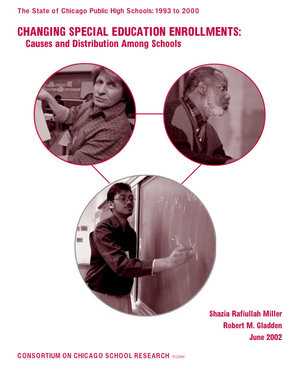This series tracks the performance of Chicago public high school students from 1993 to 2000 using data from the last two years of Phase I reform as a baseline for looking at the first five years of Phase II. This report examines the rise in the percent and number of students eligible for special education services and their distribution across schools.
This report examines in detail the upward trend of special education enrollment in the high schools. The enrollment of students with disabilities in the ninth grade increased substantially between 1993 and 2000. During this period, a larger percentage of elementary students were identified as having a disability, particularly in the gate grades, and most often under learning disabled classification. Although the proportion of students with disabilities that was retained only rose slightly, the proportion of general education students that was retained or sent to an Academic Preparatory Center (APC) rose dramatically, thereby shifting proportional enrollment. Moreover, students with disabilities were heavily concentrated in neighborhood high schools (rather than selective admissions, charter, small, or extended elementary schools). Eleven neighborhood high schools, all on probation and located in areas with disproportionately high levels of low-income residents experienced an especially large increase in their enrollment of students with special needs. The overall growth of special education enrollment across the system resulted in the increased separation of students with learning disabilities from general education students in high school classrooms, especially in schools where a larger proportion of students with disabilities were served.
The report includes system wide trends as well as school-by-school analyses of the percent of students with disabilities in each school's ninth grade and their change in enrollment since 1993-94.
